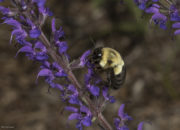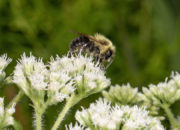By far the most commonly encountered bumble bee in Vermont – at some sites, can be incredibly dominant, especially late in the season. Appears more tolerant of development than most other species and is less common at heavily forest sites, though can show up anywhere, from the alpine zone of Mt. Mansfield to downtown Burlington.
Identification: The only species without any yellow on T2, though there are occasionally a few yellow hairs at the top of T2 . Shorter haired than similar species, with a dusky smudge instead of a well defined dark spot on the abdomen. The yellow on T1 usually appears slightly concave in the middle. Occasional specimens (<1%) have a reddish tinge to the otherwise black hair on T2 – T4 (see example here). Males are similar to females, and rarely appear before late August.
Similar Species: Two-spotted Bumble Bee (Bombus bimaculatus): has a similar pattern on the abdomen, though brighter yellow with longer hair. Always at least a few yellow hairs in the middle of T2.
Half-black Bumble Bee (Bombus vagans): can be superficial similar, as T1 and T2 can be hard to distinguish when both are yellow
Global Status: Secure (G5)
Vermont Status: Secure (S5)
For more information, visit the following links:
Discover Life
Living Atlas Species Page
Distribution:
To see the global distribution, check out the iNaturalist account, and toggle the GBIF layer on the map.








